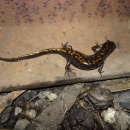About Us
Antioch Dunes National Wildlife Refuge is the only national wildlife refuge in the country established to protect endangered plants and insects – the Antioch Dunes evening primrose, the Contra Costa wallflower, and the Lange’s metalmark butterfly.
Created in 1980, the 55-acre refuge was once part of a larger sand dune system that stretched two miles along the southern bank of the San Joaquin River east of the City of Antioch. The sand dunes were formed by ancient deposits of glacial sands carried downriver from the Sierra Nevada. Over thousands of years, ocean winds and bay tides slowly shaped these aeolian (wind-blown) sands into dunes that approached 120 feet in height. Isolation of these dunes resulted in the development of species of plants and insects that were found nowhere else in the world. In 2022, another 12 acres were added to the refuge bringing the total area to 67 acres.
Large-scale sand mining and industrial development fragmented the sand dune habitat until only a small portion of the original ecosystem remained. What is left today are two disjunct parcels (the Stamm and Sardis Units) containing sand dunes varying from 0-50 feet high, making up refuge.
Due to the sensitivity of the habitats and the endangered species, the refuge is not open to unsupervised use by the public. However, refuge staff and local educators conduct on-site environmental education efforts through monthly guided tours and special events. Volunteers also regularly assist refuge staff with habitat restoration projects and endangered species surveys.
Our Mission
The mission of the National Wildlife Refuge System is to administer a national network of lands and waters for the conservation, management and, where appropriate, restoration of the fish, wildlife and plant resources and their habitats within the United States for the benefit of present and future generations of Americans.
Our History
The Antioch Dunes were once a large, ancient, aeolian (wind blown) dune system extending along the southern bank of the San Joaquin River just east of the town of Antioch. According to a 1908 U.S. Geological Survey topographic map the bulk of the dunes were along a two-mile stretch of the river, averaged approximately one-sixth of a mile wide and totaled roughly 190 acres. Isolation of this sand dune habitat resulted in the development of species and subspecies of plants and insects that are found nowhere else in the world.
Around the early 1900s, this biological "island" began to experience a dramatic change. Human development and sand mining destroyed most of the dunes that historically reached heights of 120 feet. The easily-accessible sand was mined to make bricks. Large-scale sand mining and industrial development continued to fragment the sand dune habitat until only a small portion of the original ecosystem remained. A small portion of the dunes were protected from further development and mining when the Refuge was established in 1980. However, nonnative weeds encroached on the sand dunes crowding the few remaining endangered plants. When the Refuge was established, only a few acres of remnant dune habitat supported the last natural populations of primrose, wallflower, and Lange's. The Refuge was open for public use until 1986 when it was closed to protect the endangered plants from trampling and wildfires.
Other Facilities in this Complex
The Antioch Dunes National Wildlife Refuge is managed as part of the San Francisco Bay National Wildlife Refuge Complex. Other refuges in the San Francisco Bay National Wildlife Refuge Complex include: Salinas River, Ellicott Slough, Don Edwards San Francisco Bay, Marin Islands, San Pablo Bay, and Farallon Islands National Wildlife Refuge.
The Refuge Complex headquarters is located at 1 Marshlands Rd. Fremont, CA. 94555.
A National Wildlife Refuge Complex is an administrative grouping of two or more refuges, wildlife management areas or other refuge conservation areas that are primarily managed from a central office location. Refuges are grouped into a complex structure structure
Something temporarily or permanently constructed, built, or placed; and constructed of natural or manufactured parts including, but not limited to, a building, shed, cabin, porch, bridge, walkway, stair steps, sign, landing, platform, dock, rack, fence, telecommunication device, antennae, fish cleaning table, satellite dish/mount, or well head.
Learn more about structure because they occur in a similar ecological region, such as a watershed or specific habitat type, and have a related purpose and management needs. Typically, a project leader or complex manager oversees the general management of all refuges within the complex and refuge managers are responsible for operations at specific refuges. Supporting staff, composed of administrative, law enforcement, refuge manager, biological, fire, visitor services, and maintenance professionals, are centrally located and support all refuges within the complex.




